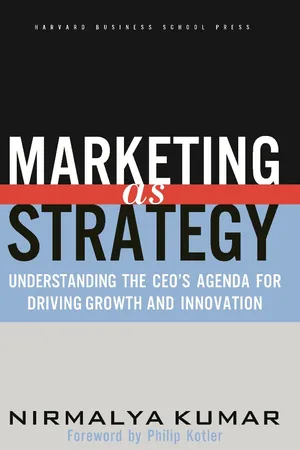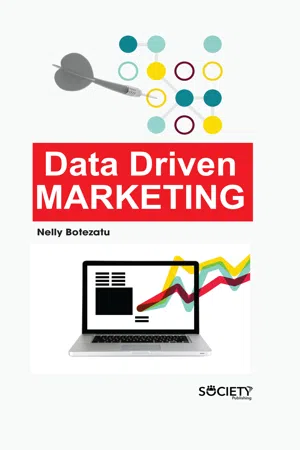Marketing
Differentiated marketing
Differentiated marketing is a strategy where a company targets multiple market segments with different offerings. This approach involves tailoring marketing efforts and products to meet the specific needs and preferences of each segment. By recognizing and addressing the diverse requirements of various customer groups, companies can potentially increase their market share and customer loyalty.
Written by Perlego with AI-assistance
Related key terms
1 of 5
11 Key excerpts on "Differentiated marketing"
- eBook - PDF
Culture and Positioning as Determinants of Strategy
Personality and the Business Organization
- Tony Ellson(Author)
- 2004(Publication Date)
- Palgrave Macmillan(Publisher)
In Market segmentation Survey, analysis, profile Market targeting Evaluation and selection Positioning A distinctive place in the mind of the target market Figure 1.1 Traditional process of segmentation, targeting and positioning Context and Rationale 5 contrast, differentiation is characterized by heavy advertising and ‘may be classified as a promotional strategy or approach to marketing’ (6) that attempts to persuade the buyer to favour one supplier over another to establish a firm market position and to enhance the buyer’s willing- ness to pay higher prices. These observations in relation to market segmentation and differentiation suggest the need for regular review by the marketer to take account of the changing market and needs of customers (5). Importantly to the marketer, Smith (1956: 5) draws atten- tion to the integrated nature of strategic planning in respect of its influence on both manufacturing and marketing: ‘Strategy determination must be regarded as an over-all management decision which will influence and require facilitating policies affecting both production and marketing activities’. The overall management decision is also directed by other influences that pertain to the nature of the organization such as the ability and willingness to control costs (Smith, 1956: 7). The approach of a business to strategy determination is dependent on a variety of inherent factors within the organization including the way that it perceives its own pur- pose (Levitt, 1960). Levitt (1960) portrays the alternative approach as a business without a sense of purpose or direction, lacking any panache and comprised of separate functional parts ignoring the need to motivate customers to want to do business. This approach does not preclude the need to intensify the emotions of the customer through the use of ‘advert- ising’, ‘industrial design’, and ‘packaging’, but rather augments the product: ‘All goods and services are differentiable . - eBook - PDF
Principles of Marketing
A Value-Based Approach
- Ayantunji Gbadamosi, Ian Bathgate, Sonny Nwankwo(Authors)
- 2013(Publication Date)
- Bloomsbury Academic(Publisher)
Nonetheless, it is important to note that an unDifferentiated marketing approach is becoming rarer with the ever changing marketplace and increasing competition. Products that used to exemplify an undifferentiated method no longer do so and variations now exist, possibly in response to market demands. See Table 5.1. Table 5.1: Differentiation in previously undifferentiated markets Differentiation in the bottled drinking water market Differentiation in the petrol market Differentiation in the salt market Still water • Spring water • Purified water • Mineral water Sparkling water (also called carbonated or fizzy) • Spring water • Purified water • Mineral water Flavoured water (wide variety exists) Differentiating the petrol itself • Unleaded • Leaded Differentiating extended products • Providing mini supermarkets • Providing car services such as car wash, change of oil, tyre air pumps • Providing cash machines Table salt Cooking salt Low-sodium salt Iodized salt Garlic salt Celery salt Sea salt Differentiated marketing strategy Differentiated marketing is also known as segmented marketing . Here, the organiza-tion chooses to operate in a number of market segments. This requires that different products are designed to suit the particular needs of each segment. A Differentiated marketing strategy is used in sectors such as the cosmetics, personal hygiene, food, airlines, fashion, mobile phones and car markets. In the automobile industry, for instance, companies target a variety of segments using a range of options such as engine size, automatic or manual transmission, petrol or diesel engine, upholstery and status add-ons (customized, exclusive models). In the personal hygiene market, Colgate’s website (http://www.colgate.co.uk/app/Colgate/UK/OralCare/Product Recommender/Toothpaste.cvsp) shows that it has about 26 toothpaste ranges for adults. - eBook - PDF
Marketing As Strategy
Understanding the CEO's Agenda for Driving Growth and Innovation
- Nirmalya Kumar(Author)
- 2004(Publication Date)
- Harvard Business Review Press(Publisher)
From Market Segments to Strategic Segments If you went out of business, would anyone miss you? M arketing’s basic mission is to create a difference between a company’s offering and that of its competitors on an attribute important to customers. To create differentiation, marketers use segmentation , targeting , and positioning , or STP. Market segmentation is the process of dividing the market into homogeneous groups of customers who respond similarly to a particular marketing mix of the four Ps—product, price, place, and promotion—the essential tactical tools for positioning the firm’s offer to the targeted segment. Not surprisingly, any market-ing practitioner can comfortably converse in terms of market seg-ments, target markets, and positioning. One of the biggest frustrations of CEOs is their marketers’ inability to create such perceived differentiation among offerings. The tactical orientation has led marketers to rely too heavily on the marketing mix, which has limited how deeply they can differ-entiate in strategic segments. This deeper differentiation is critical to create distinguishing benefits that are sustainable and avoid commoditization. In contrast to the relatively shallow market segment differ-entiation created through the exclusive use of the four Ps, deep differentiation is achieved by building the firm’s source of com-petitive advantage into the value network that serves a partic-ular strategic segment. 1 The value network—the cross-functional orchestration of activities necessary to effectively serve the chosen segment—includes differentiation based on the four Ps. 2 But it also goes beyond marketing, to encompass differentiation on other functions such as R&D, operations, and service. This chapter begins by describing how marketers view seg-mentation. - eBook - PDF
Strategic Business Planning for Accountants
Methods, Tools and Case Studies
- Dimitris N. Chorafas(Author)
- 2006(Publication Date)
- CIMA Publishing(Publisher)
Positioning requires market and product know-how; education, and training in sales methods; information dissemination and direct client contact; rational, competitive pricing (see Chapter 14); and able client account management. It also requires a marketing budget that sustains a first-class sales effort, including longer-term client handholding. Market differentiation focuses the company’s efforts on its strengths, which put it ahead of competition. Effective client handholding is crucial in market differ-entiation, which calls for: relationship marketing, personalized sales orientation, high quality services, client counselling, and other means of sustaining the client relationship. Training, both of the customers and of the sales force, is a way to market differentiation. Market segmentation is based on research that addresses demographic and other factors; business opportunity analysis; customer classification according to needs for products and services; customer classification regarding the amount of business done with them; as well as design, pricing, and marketing of products directly related to each market segment. Also, intersegment complementarity of services, and profitability analysis of segment-linked offerings. In connection to all three pillars – positioning, differentiation, and segmentation – marketing decisions must deal effectively with the firm’s internal and external policies. They should also overcome organizational barriers, structural imped-ances, status symbols standing in the way, and information insufficiencies. Success on all these axes is instrumental in picking up a marketing strategy. Equally important is to manage the risk inherent in testing out new sales concepts, in a way that has a positive impact on obtained results. Modern banking, for example, is characterized by two main drives: market seg-mentation and value differentiation. - eBook - PDF
Business Administration Education
Changes in Management and Leadership Strategies
- Satinder Dhiman, J. Marques, S. Holt(Authors)
- 2012(Publication Date)
- Palgrave Macmillan(Publisher)
Segmentation, also referred to as market segmentation, is the division of consumer mar- kets into meaningful and distinct consumer groups (Levens, 2012). The purpose of creating these groups is to more effectively deploy marketing-mix strategies against those meaningful and distinct groups. The concept of segmentation has long been identified as a core ele- ment of marketing management. Following Frederick’s initial work in 1934, Wendell Smith published an influential paper on segmentation in 1956 titled “Product Differentiation and Market Segmentation as Alternative Marketing Strategies” (Fennel & Allenby, 2002; Goller, Hogg & Kalafatis, 2002). Smith defined segmentation as “viewing a heterogeneous market as a number of smaller homogeneous mar- kets, in response to differing preferences, attributable to the desires K now ing Our Audience 67 of customers for more precise satisfactions of their varying wants” (Wedel & Kamakura, 2002). Product differentiation was identified as a collection of marketing strategies implemented to address the actions of a brand competitor (Fennel & Allenby, 2002). Segmentation was introduced as a broader concept that links marketing strategies to an understanding of the variety of wants that individuals bring to a market (Fennel & Allenby, 2002). The idea of segmentation has evolved to refer to a search for groups of individuals with similar market responses (DeSarbo, 2001). These responses are consistent within a particular group but different from other groups (Lerer, 2002). In order to qualify as a true segment, a group must meet several criteria (Dexter, 2002): (a) A homogeneous set. (b) A critical mass. (c) Core similarities of attitude, behavior, and economics. (d) Different from other segments. (e) Robust and replicable over time. Segmentation is not about explaining why users of various brands are different. - eBook - PDF
- (Author)
- 2010(Publication Date)
- Harvard Business Review Press(Publisher)
Your decision on a marketing mix needs to be coherent. For example, if you’re marketing a commodity product, you wouldn’t want to give it a high list price. Differentiating your offering Another approach to defining a marketing strategy is to consider how you might differentiate and position your promising product or service and how you might create a brand for it. Differentiation is the act of distinguishing your company’s offering from competitors’ offerings in ways that are meaningful to consumers.You can differentiate products physically or through the services your company provides in support of the product. Products’ physical distinctions include: • Form —size, shape, physical structure, for example, aspirin coating and dosage • Features —such as a word processing software’s new text-editing tool • Performance quality —the level at which the product’s primary characteristics function Developing Your Marketing Strategy 41 • Conformance quality —the degree to which all the units of the product perform equally • Durability —the product’s expected operating life under natural or stressful conditions • Reliability —the probability that the product won’t malfunction or fail • Reparability —the ease with which the product can be fixed if it malfunctions • Style —the product’s look and feel • Design —the way all the previous qualities work together (the product is easy to use, looks nice, and lasts a long time) Products’ service distinctions include: • Ordering ease —how easy it is for customers to buy the product • Delivery —how quickly and accurately the product is delivered • Installation —how well the work is done to make the product usable in its intended location • Customer training —whether your company offers to train customers in using the product • Customer consulting —whether your company offers advice or research services to buyers of the product • Maintenance and repair —how well your company helps customers keep the product in good working order - eBook - PDF
- O. C. Ferrell, Michael Hartline, (Authors)
- 2018(Publication Date)
- Cengage Learning EMEA(Publisher)
Customers, Segmentation, and Target Marketing INTRODUCTION In this chapter, we begin our discussion of marketing strategy by examining custo- mers, segments, and target markets. In Chapter 1, we referred to a market as a col- lection of buyers and sellers. Now, we focus our attention on the buyers who collectively make up the major portion of most markets. From this perspective, we concern ourselves with markets as individuals, institutions, or groups of individuals or institutions that have similar needs that can be met by a particular product offer- ing. As we shall see, firms can attempt to reach all buyers in a market, smaller groups or segments of the market, or even specific buyers on an individual level. Whether the firm aims for the entire market or smaller market segments, the goal of market- ing strategy is to identify specific customer needs, then design a marketing program that can satisfy those needs. To do this effectively, the firm must have a comprehen- sive understanding of its current and potential customers, including their motiva- tions, behaviors, needs, and wants. The ability to determine in-depth information about customers is a fairly recent phenomenon in marketing. Fifty years ago, for example, technology and marketing know-how were less sophisticated. Marketers of the day were unable to fully under- stand customers’ needs and wants, much less make fine distinctions among smaller segments of the total market. Marketers tended to offer products that came in only one variety, flavor, or style. Today, market segmentation is critical to the success of most firms. Segmentation allows marketers to more precisely define and understand customer needs, and gives them the ability to tailor products to better suit those needs. As discussed in Beyond the Pages 5.1, the level of detailed information avail- able about customers today has changed the way firms do business. However, the use of such information raises concerns about consumer privacy. - eBook - PDF
Marketing Management N4 SB
TVET FIRST
- CH Esterhuyse R van der Merwe(Author)
- 2016(Publication Date)
- Macmillan(Publisher)
• Each consumer group will be approached in a different way. • One marketing mix will be developed for each segment. • There will be different prices for each group of consumers. • Example: marketing that focuses on more than one group of pet owners form the target market, such as dog and cat owners. • Higher sales are possible. • Production and marketing activities could be more economical. • There will be higher costs associated with attending to two or more market segments. • It may reach a stage where one segment helps the other segment to survive. Concentrated approach • One well-defined group of consumers forms the target market. • One marketing mix will be developed. • There will be one price range for this specific group of consumers. • Example: marketing that concentrates on dog owners only. • The business can meet the needs of a narrowly defined segment better. • The product or service can be positioned more effectively. • If the business concentrates on one segment, this segment may be too small to be profitable. • If this one segment changes, then the business will have to change too – or find another market segment. 124 Unit 4.3: Choice of target market Comparing the undifferentiated-marketing approach and the differentiated-marketing approach We can compare these two approaches to segmentation: mass marketing and segmenting a market. • When the business focuses on the mass market – e.g. the market for pet owners – it develops one marketing mix. • When the business focuses on one or two segments of the market – e.g. dog and cat owners – it should develop a marketing mix for each segment of the market. Definition of ‘target market’ Very often, a business cannot serve all of the market segments it identifies. For example, it may not be able to serve pet owners of all kinds. It may, instead, have to choose dog and cat owners only. The solution is to decide which markets to serve. This decision is in the best interest of the business. - eBook - PDF
- Nelly Botezatu(Author)
- 2019(Publication Date)
- Society Publishing(Publisher)
Depending on the size of the obtained market share, marketing can be classified into: • Mass marketing, which is characterized by mass production and marketing of a single product, intended for every buyer; Data Driven Marketing 6 • Product-Differentiated marketing, which is intended for the production and marketing of several products with different characteristics on one market with the goal to rather supply variety to the market treating it as a whole than satisfy the needs of particular target segments; • Target marketing, which is designed for the production and marketing of different products, developed for specific market segments. Depending on the current situation of the demand for a company’s products, the following marketing types can be applied: • Stimulation marketing can be applied when there is little or no demand at all. Stimulation marketing in this case aims to change the indifferent attitude towards the products by searching ways of linking the product’s advantages to the needs and interests of potential consumers. This kind of marketing is oriented towards overcoming any possible reasons that may create the absence of demand by dropping the prices, increasing advertising efforts etc. • Developing marketing can be used when there is a hidden demand. Hidden demand is characterized by customers who are not satisfied by existing products. Developing marketing, in this case, has the goal of answering to the appeared hidden needs of the market by evaluating the size of the potential market and developing a new or improved product that will satisfy customers’ needs. • Remarketing can be applied when there is a decrease in demand. Remarketing aims to recover decreasing demand caused by a failed artistic marketing approach used previously. It consists of searching for new opportunities, attributing new characteristics to the products or penetrating new markets in order to revive demand and regain market share. - eBook - PDF
Market-Driven Management
Strategic and Operational Marketing
- Jean-Jacques Lambin, Isabelle Schuiling(Authors)
- 2012(Publication Date)
- Bloomsbury Academic(Publisher)
Several market coverage strategies can be considered. In a 14 Market-Driven Management focused strategy, market boundaries are defined narrowly. In a full market coverage strategy , two options exist: (a) a “mass marketing” strategy, where the firm focuses on what is com-mon in the needs of customers rather than on what is different; (b) a “mass customization” strategy, where the firm approaches the market with a tailor-made programme for each segment. In a mixed strategy , t he firm diversifies its activities to ensure that its portfolio of activities is well balanced in terms of profit and growth potentials and well diversified in terms of risks. Step 6: How do we want to compete in the target segment(s)? (see Chapters 11 and 12) Once the market coverage decisions are made, the next step is to decide on the position-ing strategy to adopt within each targeted segment(s). Selection of the positioning strategy provides the unifying concept for the development of the marketing mix programme. This is one of the most critical steps in the implementation of strategic marketing, because the firm has to decide how to best differentiate its brand from competing brands. Positioning is defined as the decision made by the firm to choose the benefit(s) that the brand has to put forward to gain a distinctive place in the market. In a price-sensitive market, product positioning generally requires a lower price, because other sources of differentiation are not valued by target customers. For markets in which differentiation is possible and valued by target customers, three types of differentiation strategies are possible: product differentia-tion, price differentiation and image differentiation. The objective of the company will then be to communicate clearly the chosen positioning to potential customers so that it is clearly recorded in their minds. - eBook - PDF
- Louis E. Boone, David L. Kurtz, Michael H. Khan, Brahm Canzer(Authors)
- 2016(Publication Date)
- Wiley(Publisher)
301 Chapter 11 Customer‐Driven Marketing SOLVING AN ETHICAL CONTROVERSY (continued) are ice skates, tomato sauce, and a haircut. Business products—or business‐to‐business (B2B) products—are goods and services purchased to be used, either directly or indirectly, in making other goods that will be resold. Some products can fit either classification depending on who buys them and why. For example, a computer and a credit card can be used by both a business and a consumer. A target market is the group of possible customers that an organization directs its marketing efforts toward. Customer needs and wants differ, and no single organization can satisfy everyone. For example, Popular Science is a magazine geared toward readers who are interested in science and technology, whereas Bon Appétit is aimed at readers who are interested in fine food and cooking. Decisions about marketing involve strategies for four areas of marketing activity: product, distribution, promotion, and pricing. A firm’s marketing mix blends the four strategies to fit the needs and preferences of a specific target market. Marketing success depends not on the four indi- vidual strategies but on their unique combination. Product strategy involves more than just designing a good or service by adding needed quali- ties. It also includes decisions about package design, brand names, trademarks, warranties, prod- uct image, new‐product development, and customer service. Think about your favourite pair of jeans. Do you like them because they fit the best, or do other qualities—such as styling and overall image—play a role in your brand preference? Distribution strategy, the second marketing mix vari- able, ensures that customers receive their purchases in the proper quantities at the right times and locations.
Index pages curate the most relevant extracts from our library of academic textbooks. They’ve been created using an in-house natural language model (NLM), each adding context and meaning to key research topics.










